If you are signed up for an IPAF Operator course you might want some information on what you will be doing on the day. Everyone likes to be prepared, both physically and mentally for any given assignment.
Who is the IPAF Operator Course For?
The IPAF Operator training course is designed for personnel who are in charge of using MEWPs in the categories 3A (Scissor lifts) and 3B (Cherry Pickers) in their place of work. There are no entry requirements for delegates although experience and a basic working understanding of MEWPs is advantageous for those who seek to successfully complete the course in one day.
IPAF Practical Test
For the practical part of the test there will be a large, well ventilated training area that will allow for social distancing guidelines to be adhered to and for everyone to be and feel safe at all times. There are clear and strict provisions made to sanitise all equipment before and after use. The practical test is staggered at different times throughout the day to allow for smaller numbers on any given test. This is a factor that has already proved invaluable to businesses that are left short-staffed due to furloughing. In essence they will not lose delegates for an entire day, but rather a maximum of several hours for the practical test.
Best Practice
Everyone taking the course will be instructed on best practice when it comes to the safe operation, optimal selection and thorough inspection of MEWPs in the workplace. In addition all attendees are made aware of the best practice in the wearing and maintenance of their PPE, specifically safety harnesses.
Most Popular IPAF Courses
The 3A/3B modules are the most popular in terms of attendance, but there is also a PAL+ course, that beefs up these modules to make them more relevant for operators who are tasked with using MEWPs on more challenging terrain and difficult environments.
IPAF Pal Card
After equipping themselves with the necessary safety kit each delegate will be introduced to the MEWPs that they are going to use for the practical learning and test. The instructor will help them get to grips with the safety features, structural parts and workings of the model they’re using and they will learn about maintenance checks and inspections. After this they will be able to get into the driver’s seat and have a practice run on the MEWP, involving attempting to avoid some cones and practicing common manoeuvres in a variety of positions to replicate site operation. When they’ve got to grips with the MEWP they will be asked to demonstrate their handling skills in a practical test, which will be the final hurdle before they obtain your PAL card.





